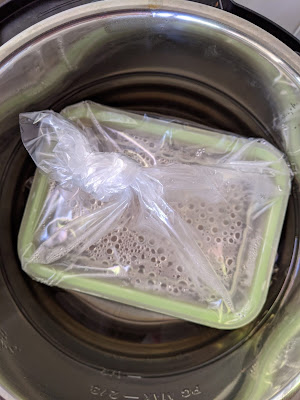Please see here and here to learn more about concentrated lactic acid sourdough (CLAS).
With CLAS, making 100% whole-spelt bread with freshly milled flour is simple; anyone can do it. Without using fat, dairy, sugar, or vital wheat gluten, and without turning on the big oven, you can enjoy an aromatic and wholesome loaf in just a few hours through proper dough development and fermentation.
Ingredients
10% flour from whole-spelt CLAS


90% freshly ground whole-spelt flour
15% water from whole-spelt CLAS
50% water, ~40-45°C
7% water
1.8% salt
0.7% dry yeast
Total dough weight 580g
Mix
x 20-30 mins
Dough temp ~31-32°C
Bulk ferment
38-40°C x 50 mins
Shape
round
Prove
35°C x 25 mins
Bake
400F x 19 mins, covered with a stainless steel dish
remove the stainless steel dish
400F x 20 mins
flip
400F x 20 mins
check
flip
400F x 5 mins browning the top
Grind the spelt berries in the Vitamix

until silky-smooth.

Add whole-spelt CLAS to the Zo.

Mix the dough in the Zo.
If you prefer to increase the dough's hydration, refer to this post for detailed mixing directions.

Dough temp ~31-32°C

Witness the remarkable gluten development of this 100% whole-grain dough within 30 minutes!
CLAS rocks!



Ferment the dough in the Zo,using Zo's preset "Rise 3" feature.
~38-40°C x 50 mins

Shape the dough and transfer it to a cake pan, covering it with a pizza pan.


Prove the dough in the Instant Vortex using its dehydrating feature.
35°C x 25 mins

proved

Score the dough to maximize rise and bloom in the air fryer.

Bake in the Instant Vortex without preheating, covering the pans with an inverted stainless steel dish.

400F x 19 mins
remove the stainless steel dish
400F x 20 mins
flip
400F x 20 mins
check
flip
400F x 5 mins browning the top

I forgot to take pictures of the bottom. 


The crumb.

That's it!














 How to make whole-spelt CLAS
How to make whole-spelt CLAS
ground wheat malt: 25g
Whole grain spelt flour: 75g
Water T. 45°C: 140 ml
Vinegar (5% acidity): 10 ml
Fermentation temperature: 38°C±2°C
Fermentation time: 24-36h
Hydration: 150%
End pH: around 4
To refresh spelt CLAS
1:7 (spelt flour in CLAS: new spelt flour), no vinegar needed
150% hydration@38+-2 C x 12 hours
I usually make about 500g of CLAS at a time with 200g of grains. It stays in the fridge until I need it to bake, and I stir it thoroughly before use. I usually warm it up with one of Zo's fermentation features while I prepare the remaining ingredients. When I've used up most of the 500g of CLAS, I refresh it using the 1:7 ratio to make another 500g, give or take.
I set up a water bath (~low 40s C) in the Instant Pot, support the container with a trivet, and use the Instant Pot's yogurt feature to make CLAS:

Then cover it with the lid.
P.S. 20230722 





I can also make CLAS in the Zo using its 'Rise 3' feature because it operates within the same temperature range as a yogurt maker. I can either take out the bread pan, place the container with CLAS in the bread machine, supporting it with a trivet, or ferment the CLAS directly in the bread pan.